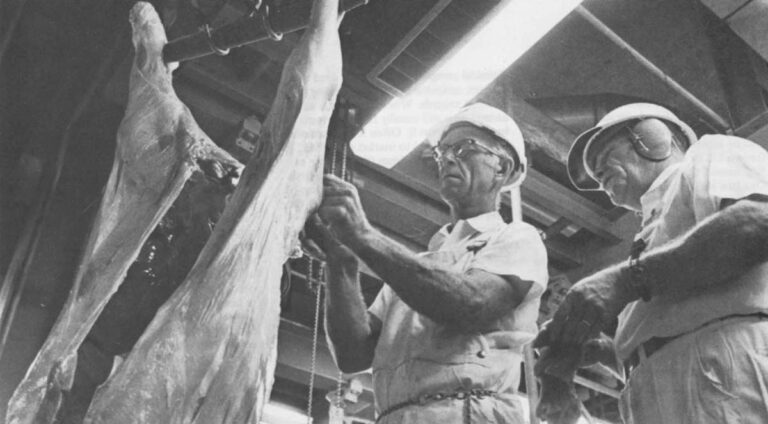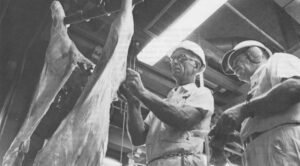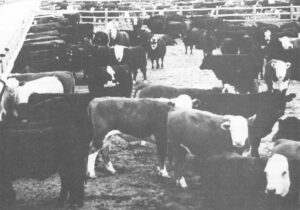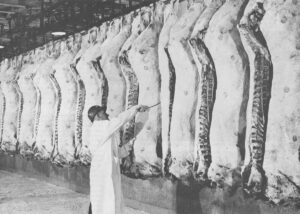BOLINAS, CA.– “OK. You see that discoloration here, that’s caused by pneumonia,” says Dr. Thomas Harris, DVM, Inspector-in-Charge for the U.S. Department of Agriculture’s Meat and Poultry Inspection Program. He points at a large pink bovine lung, and slices into it with a butcher knife. Next to it are a jumble of other internal organs which have just been removed from a freshly butchered steer, which hangs upside down behind Harris minus its hooves, head, and tail on an overhead track.
Harris is a meat inspector at McDermott’s Formula Fed Beef packing plant just across the bay from San Francisco, beside Interstate 80.

“I can’t pass a lung like like that;’ says Harris, stamping it, “Condemned” with a purple stamp and dispensing it into a large plastic drum marked “DOG FOOD” “It’s OK for dogs. But first it’s got to be cooked and sterilized, because you know there are a lot of people out there, you know, poor people, who eat canned dog food.”
As he speaks, a burly man with tattooed arms wheels another stainless steel cart load of internal organs and offal over to Harris for his perusal. Still warm from the animal’s stomach cavity, they steam in the unheated winter air of the killing room.
The killing room which Harris watches over is indeed suggestive of an assembly line in a factory. The entire room is filled with beef carcasses which hang down like macabre pinatas in various states of dismemberment.
The dead animals, their throats slit and tongues hanging limply out, snake their way through the various stations of the killing room on an overhead track like surrealistic skiers on a lift. Once the animal is killed, bled, and hung by the ankles, hooves are removed with gigantic hydraulic pincers, the head is unceremoniously severed off, the animal is skinned and the back fat is trimmed.
Just before the animal is sawed in half by a meatcutter on a mechanical hoist with chain saw, it is eviscerated by the man with the tattooed arms. It is here that Harris works, assaying the stripped carcasses and performing his modern-day auguries over the stainless steel trays of internal organs which are endlessly wheeled over to him from the assembly line for his inspection.
Unlike an assembly line, where workers and machines usually labor to assemble products of one sort or another, here, the process is reversed. An already complete animal arrives in the killing room from outside pens, is killed, and then slowly disassembled; its constituent parts slowly removed and sorted into hampers, barrels and racks as if an industrial film were being run in reverse.
As I watch, Harris inspects a pancreas and then begins to slice open several lymph nodes.
“If you see any blood or discoloration here, that’s a definite sign to start looking for pathology or other kinds of toxicity. The lymph nodes are like a filtering system. Sometimes we see signs of cancer. If the tumor is benign, we will pass it. But if it is malignant and has spread, out it goes.” Harris sticks up his bloodied right thumb and makes a gesture like an umpire calling a runner out at home plate.
Harris, whose job it is to stand here on the line like St. Peter at the Gates of Heaven judging which bovine carcasses and internal organs are fit for entry into the meat markets of America, is a handsome man with a black moustache. He wears a white hard hat, a rubber apron over his white smock and earphone mufflers like those worn by airport mechanics and baggage handlers to dampen the deafening cacophony of sounds: steam being released, the clanging of steel on steel as animals move down the line, the high pitched whine of the hide and tallow removers, and the snarling of a large chain saw used to split carcasses into sides of beef.
Harris stands in the middle of the noisy room wearing a wooden scabbard of cutlery slung around his waist. Beside him is a clip board covered with a plastic sheet to keep blood from the animals and water from the high-pressure hoses from splattering a list. “Flukes’; “Telang’; “Granuloma’: “Pneumonia’: “Cervical Abcess’: “Arthritis’ – “Liver.” Clumps of check marks have been placed after several of the headings indicating the maladies which Harris has found since he came to work today at 3:30 this morning.
“Actually, it’s been a pretty good day,” he says, as I glance at his log. “We do get batches of bad animals. The feedlots will just ship ’em out, even though they’re sick, and hope they’ll get through. Last Thursday out of one load of sixteen cows, I had to reject four. One for arthritis and three for injection lesions. They were hospital cattle someone just decided to try and get rid of. It was obvious.” He steps over to a small stainless steel sink and rinses the blood off his hands and knife.
“Some of the slaughter houses out there are just killing shit,’ he continues. “They don’t care. They buy junk cows at ten cents a pound and sell them at $1.50. What the hell! They can afford to have a few carcasses condemned.
“Actually, we’re just a medium size plant here,” says Harris when there is a lull in the assembly line. “We get by here with one vet. But you go into one of these houses where they’re killing 300 an hour, and they will have a lot of inspectors who are not vets. You know, they just work under the supervision of a vet. If they see something strange, well, then they call the vet. But, I’ll tell you, I’ve been in some of those houses where they’re killing a lot of old cows, and they have trouble with almost every single animal. Here we’re killing top-of-the-line animals and we still have to keep on our toes.”
Like a samurai, he slices deftly into the bile duct of a large jello-like liver before him. He holds his butcher knife aloft. On the end of it are several small flat brown nematodes which look like pieces of a whole wheat noodle.
“We’re looking for a lot of things. But one of the biggest problems we have is liver flukes. There is no FDA approved drug for them now, and they are very common.” He scrapes the flukes off his knife onto the floor, and then slices tic-tac-toe crosses in the flat surface of the purple organ before him.
“If I’m rejecting an organ for dog food, I put crosses on it. If I reject it completely, I put x’s on it. That means it can only be ground up for fertilizer.”
The organs of the next animal are wheeled over for Harris’ inspection. He passes them as fit for human consumption, and places them on a rack to one side where they hang on hooks in neat rows like boxing gloves.
“You can generally tell the state of an animal’s health from the internal organs,” says Harris, pausing for a moment. “After a while the sick ones really just jump out at you.”
“You can also tell a lot about meat by looking at the color of the fat. Grass fed beef is yellower. When you put them in a feedlot and grain them out, the fat will whiten up. These haven’t been in a feedlot long enough,” he says, pointing at the advancing row of brackish colored carcasses.
Sharpening his knife, Harris strides over to another rack where the skinned and detongued heads of the cattle hang on hooks with their eyes bulging out like so many Georgia O’Keefe still-life subjects. He grabs a head with a steadying hook and slices a few pieces of flesh off each cheek.
“There is one stage of the tape worm which will encyst here,” he says, stabbing at the cheek area with his knife. “You eat it, you get it.” He winks.
Then, he walks over to check a carcass before it moves on to be sawed in half.
“What I’m looking for here is needle marks which might suggest that the animal has been shot up with some drug just before shipping. If I find anything suspicious here, I will order them to retain the carcass for testing. Of course, it will take about 14 days to get some of these tests back from the labs, and by that time the meat is out in the stores. About all we can do is note which feedlots are giving us trouble and watch them, and in real serious cases, like PCBs, try to recall the meat.”
“Let me tell you, at some of these slaughterhouses where you are constantly up against management pressure to pass carcasses through, it can get real nasty being an inspector.”
“We’ve got veterinarians and meat inspectors in every packing plant,” says John Spaulding, Director of the USDA’s Residue and Evaluation Surveillance Division in Washington, D.C. “Of course, they are not just there to check for residues, but to inspect carcasses for disease as well.”
“Every month in Washington, a computer will spit out a list which tells each plant what to be testing for as part of our normal ‘objective’ testing program,” says Harris. “They decide according to what kind of animals you’re killing. If you’re just doing steers and heifers, they may tell you just to test selectively. But if you’re killing old cows, they will probably have you testing for twelve to fifteen things, everything from antibiotics to PCB’s, organophosphates, growth hormones like DES, Sulphanomides, arsenic (often used as a growth promotant in feed), you name it.”
“Our decisions on what to test are made up yearly on the basis of past toxicological history,” says Spaulding. “The whole program for monitoring is run through computers. We feed in the data, and the computers will randomize our samples and tell us what samples to take where and when. We end up testing for anywhere from twenty to thirty compounds on a routine basis. But there are certain compounds, like the chlorinated hydrocarbons, sulpha drugs and antibiotics which are chronic troublemakers. So even though we start out at the first of the year with a tentative plan for routine monitoring, we are always getting thrown off by emergency contaminations. You know PCBs in poultry. DES in cattle. Our labs just get plugged up. So finally, it is our lab capacity rather than our plan which determines what we test for.” Spaulding speaks of these limitations with a note of exasperation in his voice.
“Our problem is that we’re at the wrong end of the chain,” he continues. “I mean, we aren’t a police system. We’re only a monitoring program. And except for our routine random testing, it’s only after we get wind of a problem that our surveillance begins.”
“We have no power of inspection out on the farms themselves. We have no way of influencing how well that end of the system functions. Controls on exposure to the toxic substances and drug residues doesn’t exist. No one tells us that an animal has been double dosed on some drug before it is shipped.”
“We can only tell after something has gone wrong. We have no program for prevention. We can’t even get samples before slaughter. After slaughter, the animal has usually gone to the stores and been eaten by the time our tests come back from the labs on our random sampling.”
“We’re like a police department that doesn’t even have the crimes reported to it. We have to find them out ourselves. That’s the weakness of our program. And unless we set up a special surveillance program, a lot of stuff can just slip through. That would cost us millions of dollars. I mean, how much is the consumer willing to spend on protection?” asks Spaulding, his exasperation having now escalated into signs of outright dissatisfaction.
“As meat inspectors, we’re what stands in between the meat eating public and the wild blue yonder,” says Dr. Harris, back on the killing floor at McDermott’s. “I’m paid by the USDA, and have nothing to do with this company other than the fact that I just happened to get assigned here. I’m not only looking for drug residues, but evidence of a whole group of other toxic chemical compounds which are used in modern agriculture. I’m also looking for diseased animals. Where you find a sick animal, you will usually find that someone has tried to treat it. Often in the scramble to get that animal to market on its feet, the proper withdrawal times (the number of days or weeks which must elapse between the last time a drug or chemical was administered to an animal and slaughter time) have not been observed.”
Just then a loud buzzer rings on the killing room floor, signaling morning coffee break. I follow Harris down a windowless corridor to a small battered green door displaying a sign which reads, “USDA Field Operations Meat Poultry Inspection Program.”
“Each morning I’ll go out into the pens and inspect the cattle that have been brought in the night before. If I see a sick looking animal or one that shows any signs of contamination, I’ll tag it. Then when it gets in here, I’ll take a sample for the lab in San Francisco. You know, it could be a pesticide, a drug or even something completely unrelated to agriculture that got into some livestock feed.”
For a few moments Harris stops speaking and concentrates on trying to drink his coffee and eat two donuts.
“Antibiotics are a big one. Maybe some feedlot cowboy just didn’t want to take a chance a load of cattle would get sick on the way to the slaughterhouse, so he loads them up with antibiotics. So, I’m always looking for injection lesions. If I see one, we have a program now which allows me to run my own tests. It’s called the STOP (Selective Testing on Premises) test.”
Harris opens the door of a small incubator, which sits on his desk next to several books of USDA regulations and vet handbooks, and extracts a small glass petri dish.
“Now, these petri dishes are filled with a bacterial culture,” he says. “I’ll take a swab from the organ meat and muscle tissue of the suspected carcass, put them in here, and then place the whole petri dish into the incubator and see what happens.”
In the petri dish which Harris holds, there is an almost invisible velveteen growth of bacteria on the bottom like a microscopic lawn. It encroaches right up to the swab taken from the cow’s muscle tissue. But around the swab taken from the kidney, there is a sort of clearing.
“You see that circular blank spot?” says Harris, pointing with a half-eaten donut at the muscle tissue swab. “That’s caused by the microbial inhibition effect of the antibiotic still in the animal’s system. If a ring of bacteria dies around the swabs, I know I’ve got a problem. That means residue. Usually, I look up to see which feedlot the animal came from. I like to know who the chronic offenders are. And if I think we have a shyster who has tried to hide needle lesions, in the future, I might run tests just to check,” adds Harris with a note of defiance in his voice.
As we head back to the killing room, Harris detours briefly into a large dimly lit cooler room where sides of beef hang in rows. He stops beside one half and looks up at the haunch.
“OK. You see that?” he asks, pointing to a greenish discolored area in the fat surrounding an almost imperceptible puncture point. “You see one of those and you know you’ve got to look further. That’s probably tetracycline. I’ve done a STOP test on this carcass, and it showed unacceptable levels of antibiotic residue. But before we can reject the carcass, we have to send tissue samples off to the lab in San Francisco for further testing. That’ll take about a week. Then we’ll decide whether or not to condemn the meat.”
Harris heads off through the sides of beef toward a cage-like structure in which several plastic bags filled with organs hang.
“We’ve got to test those too,” says Harris, pointing at a liver in a large baggie. “Sometimes they’re bad even though the meat’s OK. We’ve got to lock ’em up too. That’s the rules. Somebody might try and escape with the evidence.” Harris gives a mock conspiratorial smile.
“I was a feedlot practitioner for five years back in Nebraska before I came to California, and I’ve seen what they do before they ship cattle,” says Harris as we walk back to the killing room where the disassembly line is just starting up again. “I do worry about all the antibiotics and stuff they use. I mean, let’s face it, we’ve only been using these drugs in large quantities for thirty or forty years. We don’t know what their sustained use will finally do.”
“Some people don’t think antibiotic residues are a problem,” continues Harris, sharpening one of his knives as a fresh load of internal organs are wheeled over by the meat cutter with the tattooed arms. “But I’ll just tell you something, you get these old dairy cows in here for slaughter that some farmer has been trying to keep on line by loading them up with antibiotics, and well.. .” Instead of finishing the sentence, Harris just shakes his head and puts some slash marks on the liver before him, rejecting it for abcesses.
©1981 Orville Schell
Orville Schell is investigating the U.S. Meat Industry.






